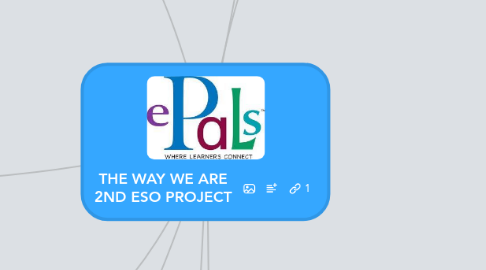
1. ASSESSMENT
1.1. When
1.1.1. 1. Diagnostic Evaluation
1.1.2. 2. Formative Evaluation
1.1.3. 3. Summative Evaluation
1.2. How
1.2.1. 1. Teacher assessment
1.2.2. 2. Self-assessment
1.2.3. 3. Co-assessment with classmates
1.3. What
1.3.1. 1. Gradual autonomy
1.3.2. 2. Implementing web tools
1.3.3. 3. Efective communication
1.3.4. 4. Colaborative work
1.3.5. 5. Interest upon learning about other cultures
1.3.6. 6. Reflection upon similarities and differences
2. OBJECTIVES
2.1. 1. Valuing English language as a communication tool
2.2. 2. Showing receptive attitude about other cultures avoiding stereotypes
2.3. 3. Fostering gradual autonomy and colaborative work to obtain significative learning
2.4. 4. Using web tools efficiently and sensible way
3. BASICS TO KNOW
3.1. 1. Students 2nd ESO of English
3.2. 2. Carried out through whole course: paralel project to formal one
3.3. 3. Interexchange with Epals group from Sweden
3.4. 4. Colaborative activities in each unit
4. METHODOLOGY
4.1. 1. Social Constructivism Perspective
4.1.1. Significant learning based on experience
4.1.2. Gradual Autonomy
4.1.3. Student centered, teacher guider and facilitator
4.1.4. Constant reflection and feedback
4.2. 2. Situative perspective
4.2.1. Social and cultural interaction
4.2.2. Colective significant learning through real situations
5. RESOURCES & INTERACTION
5.1. 1. Asincrone communication: epals portal, blogs, wikis
5.2. 2. Sincrone communication: chats and videconferences
5.3. 3. Individual, pair and group interaction
6. COMPETENCES
6.1. 1. Linguistic Competence
6.2. 2. Digital Competence
6.3. 3. Social and Interaction with the world Competence
6.4. 4. Autonomy Competence
7. ACTIVITIES
7.1. THE WAY WE ARE FIRST TERM
7.1.1. INITIAL ACTIVITIES
7.1.1.1. Let´s guess
7.1.1.2. Your own presentation
7.1.2. UNIT 1 CARTOON NETWORK
7.1.2.1. Atypical Families
7.1.2.2. The Perfect Teenager
7.1.2.3. I love Cartoons
7.1.3. UNIT 2 SUPERHERO OR SUPERVILLAIN
7.1.4. UNIT 3 AND ALL THAT JAZZ
7.1.5. UNIT 4 BREAK A LEG
7.1.6. FINAL TASK FIRST TERM
7.1.6.1. Your own mind map
7.2. THE WAY WE ARE SECOND TERM
7.2.1. UNIT 5 BREAKING STEREOTYPES
7.2.1.1. All Spaniards are...
7.2.1.2. I love Sweden
7.2.1.3. Spanish Quiz
7.2.2. UNIT 6 SAVING THE PLANET
7.2.2.1. New node
7.2.2.2. New node
7.2.2.3. New node
7.2.3. UNIT 7 WORKING FLAT OUT
7.2.3.1. New node
7.2.3.2. New node
7.2.3.3. New node
7.2.4. FINAL TASK SECOND TERM
7.2.4.1. Your own presentation
7.3. THE WAY WE ARE THIRD TERM
7.3.1. UINT 8 A WORLD OF NEW TECHNOLOGIES
7.3.1.1. Life in 140 words
7.3.1.2. How are New Technologies changing your life?
7.3.2. UNIT 9 YOUR LONDON TRIP
7.3.3. FINAL TASK THIRD TERM
7.3.3.1. Project Conclusions
8. MODELO DE LAS 5 FASES DE SALMON
8.1. Características principales
8.1.1. Se obtiene comunicación efectiva
8.1.2. Orientado hacia la consecución de tareas
8.1.3. El docente es un e-moderador
8.1.4. Diálogo online y trabajo colaborativo
8.2. 5 Fases
8.2.1. LEVEL 1: Access and motivation
8.2.1.1. Mejorado rol del e-moderador
8.2.1.2. Blog del proyecto permanente para ambas aulas como cuaderno de bItácora
8.2.2. LEVEL 2: Online Socialisation
8.2.2.1. Interacción libre entre los participantes de ambas aulas a través de los blogs personales
8.2.3. LEVEL 3: Information exchange
8.2.3.1. Se ajusta bastante a esta fase
8.2.4. LEVEL 4: Knowledge Construction
8.2.4.1. Las actividades buscan siempre propuestas colectivas: blogs, wiki, glog, trabajo final del trimestre
8.2.4.2. Se buscaría una mayor interacción entre ambas aulas en cada actividad, contando con las opiniones de los homólogos antes de llegar a la fase de reflexión
8.2.5. LEVEL 5: Development
8.2.5.1. Se facilita un fórum adicional y específico para realizar reflexiones y elaborar conclusiones de manera conjunta, dinamizado por el e-moderador

